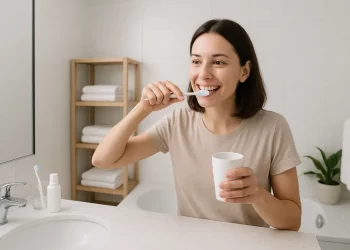Understanding Sleep’s Role in Skin Function
Your skin doesn’t rest when you sleep, it works harder than ever. During nighttime hours, your body shifts into repair mode, producing growth hormones, increasing blood flow to the skin, and rebuilding collagen that breaks down during daily activities.
Keep in mind that sleep is when your skin undergoes its most crucial regenerative processes, making quality rest essential for maintaining healthy, youthful-looking skin.
The Science Behind Sleep and Skin Repair
During deep sleep phases, your body releases human growth hormone, which stimulates cell regeneration and collagen production. Blood flow to the skin increases during deep sleep, supporting repair and nutrient delivery, delivering essential nutrients and oxygen while removing toxins that accumulate during waking hours.
Take note that your skin’s barrier function also strengthens during sleep, improving its ability to retain moisture and protect against environmental damage.
How Poor Sleep Shows on Your Skin
Immediate effects: Dark circles, puffiness, dull complexion, and increased sensitivity appear after just one night of poor sleep.
Short-term impacts: Fine lines become more noticeable, skin looks tired and lackluster, and healing from breakouts or minor injuries slows significantly.
Long-term consequences: Chronic sleep deprivation accelerates aging, weakens the skin barrier, increases inflammation, and may aggravate certain skin concerns in some people. If you have persistent conditions, consult a dermatologist.
Furthermore, inadequate sleep disrupts hormone balance, leading to increased cortisol levels that break down collagen and trigger inflammatory skin conditions.
The Optimal Sleep Environment for Skin Health
Temperature control: Keep your bedroom at a cool, comfortable temperature to support natural temperature regulation and prevent excessive sweating that can clog pores.
Humidity levels: Keep moderate humidity to prevent skin dehydration while avoiding conditions that promote bacterial growth.
Clean bedding: Change pillowcases every 2-3 days to reduce bacteria, oil, and product buildup that can transfer to your skin.
Fabric choices: Use silk or satin pillowcases to reduce friction that can cause hair breakage and skin irritation during sleep.
Also, blackout curtains and minimal electronic devices help maintain natural circadian rhythms essential for optimal skin repair.
Sleep Position and Skin Health
Back sleeping: Prevents contact between your face and pillowcase, reducing exposure to bacteria and minimizing pressure-induced wrinkles.
Side sleeping: Can contribute to asymmetrical aging and sleep lines, but using a silk pillowcase helps reduce friction.
Stomach sleeping: Places maximum pressure on facial skin and can contribute to wrinkle formation and morning puffiness.
“Many patients don’t realize how significantly their sleep habits affect their skin,” explains Dr. Shamsa Kanwal, consultant dermatologist and expert contributor to MyHSTeam. “Dermatologists note that patients often see improvements in skin texture, clarity, and overall appearance when they prioritize consistent, quality sleep as part of their skincare routine.”
Nighttime Skincare Routine for Better Sleep and Skin
1-2 hours before bed: Complete your evening skincare routine to allow products to absorb and avoid transferring to pillowcases.
Double cleansing: Remove makeup, sunscreen, and daily pollutants thoroughly to prevent clogged pores during sleep.
Treatment products: Apply retinoids (should only be used under medical supervision and avoided in pregnancy), peptides, or other active ingredients that work optimally during nighttime repair processes.
Moisturizing: Use a richer night cream to support barrier repair and prevent transepidermal water loss during sleep.
Plus, avoid stimulating ingredients like vitamin C or strong acids close to bedtime if they cause sensitivity or irritation.
Foods and Habits That Support Sleep and Skin
Sleep-promoting foods: Tart cherries, almonds, fatty fish, and herbal teas contain compounds that support natural melatonin production.
Hydration timing: Stop drinking fluids 2-3 hours before bed to prevent sleep disruption while maintaining adequate daily hydration.
Evening routine: Create consistent pre-sleep rituals that signal your body to prepare for rest and skin repair.
Screen time limits: Reduce blue light exposure 1-2 hours before bed to support natural melatonin production and circadian rhythm regulation.
Take note that alcohol and caffeine consumption, especially in the evening, can significantly disrupt sleep quality and subsequent skin repair processes.
Common Sleep Disruptors That Affect Skin
Stress and anxiety: Elevated cortisol levels interfere with sleep quality and directly damage skin through increased inflammation.
Irregular schedules: Shift work or inconsistent bedtimes disrupt circadian rhythms essential for optimal skin repair.
Sleep disorders: Conditions like sleep apnea reduce oxygen delivery to skin cells and impair regenerative processes.
Medications: Some prescriptions can affect sleep quality or skin health directly, requiring careful timing or alternatives.
Furthermore, room temperature extremes, uncomfortable bedding, and environmental noise can fragment sleep and reduce restorative benefits.
Age-Related Changes in Sleep and Skin
Young adults: Typically experience deeper sleep phases crucial for growth hormone release and collagen production.
Middle age: Sleep quality often declines due to hormonal changes, stress, and lifestyle factors, accelerating visible aging.
Older adults: Reduced deep sleep phases mean less growth hormone production and slower skin repair processes.
Hormonal transitions: Menopause, pregnancy, and other hormonal shifts affect both sleep patterns and skin health simultaneously.
Maximizing Sleep Benefits for Your Skin
Consistency: Maintain regular sleep and wake times, even on weekends, to support natural circadian rhythms.
Duration: Aim for 7-9 hours of quality sleep nightly to allow complete regenerative cycles.
Sleep quality: Focus on deep, uninterrupted sleep rather than just duration for maximum skin benefits.
Recovery: After periods of poor sleep, prioritize gentle skincare and extra hydration to support accelerated repair.
Keep in mind that it typically takes several weeks of improved sleep habits to see significant changes in skin appearance and health.
Professional Treatments That Work with Sleep
Chemical peels: If considering, consult a qualified dermatologist for suitability and risks. Adequate rest can support recovery.
Laser treatments: If considering, consult a qualified dermatologist for suitability and risks. Adequate rest can support recovery, though outcomes vary.
Injectable treatments: If considering, consult a qualified dermatologist for suitability and risks. Proper rest may support recovery, but results vary.
Prescription medications: Many topical treatments work optimally when applied before quality sleep periods.
Creating Your Sleep-Skin Wellness Plan
Assessment: Evaluate current sleep habits and identify areas for improvement that could benefit your skin.
Gradual changes: Implement sleep hygiene improvements slowly to allow your body to adjust naturally.
Tracking: Monitor both sleep quality and skin changes to identify correlations and optimize your routine.
Professional guidance: Consider consulting both dermatologists and sleep specialists for persistent issues affecting skin health.
Also, remember that improving sleep benefits overall health, making it one of the most effective investments in your skin’s long-term appearance and function.
The Bottom Line
Quality sleep is one of the most powerful tools for maintaining healthy, youthful-looking skin. During rest, your skin repairs daily damage, produces collagen, and strengthens its protective barrier.
Poor sleep shows immediately in your complexion and accelerates aging over time. By prioritizing sleep hygiene, creating an optimal sleep environment, and maintaining consistent rest patterns, you’re investing in your skin’s health and appearance.
Take note that while topical treatments and professional procedures can enhance your skin, they cannot replace the fundamental benefits of restorative sleep for optimal skin health and longevity.
Disclaimer
This article is intended for general educational purposes only and provides information about the relationship between sleep quality and skin health. It is not medical advice, diagnosis, or treatment. We are not doctors, dermatologists, or licensed medical advisors, and this content should never replace professional medical consultation.
Always seek the guidance of a licensed healthcare provider or qualified dermatologist with any questions about medical conditions, medications, skincare products, or procedures. Do not use this information to self-diagnose or to start, stop, or change any treatment without professional supervision. Retinoids and certain procedures (such as chemical peels, lasers, or injectables) should only be used under medical supervision and are not suitable for everyone, particularly during pregnancy or breastfeeding.
Any mention of doctors, clinics, or professional contributors (including Dr. Shamsa Kanwal, M.D., consultant dermatologist and expert contributor to MyHSTeam) is provided strictly for general educational purposes. Such references do not represent endorsements, advertisements, or personalized medical advice.
External links, if included, are for reference only. We do not recommend or endorse third-party websites, products, or services, nor guarantee their accuracy or safety.
All images in this article are illustrative only; they do not represent actual patients, doctors, clinics, or results.
By reading or acting upon this article, you acknowledge and agree that all health-related decisions are your sole responsibility. WellHealthOrganic.com and the authors disclaim any liability for harm, loss, or consequences resulting from reliance on this content. In case of a medical emergency or severe reaction, seek immediate help from certified professionals or emergency services.



















